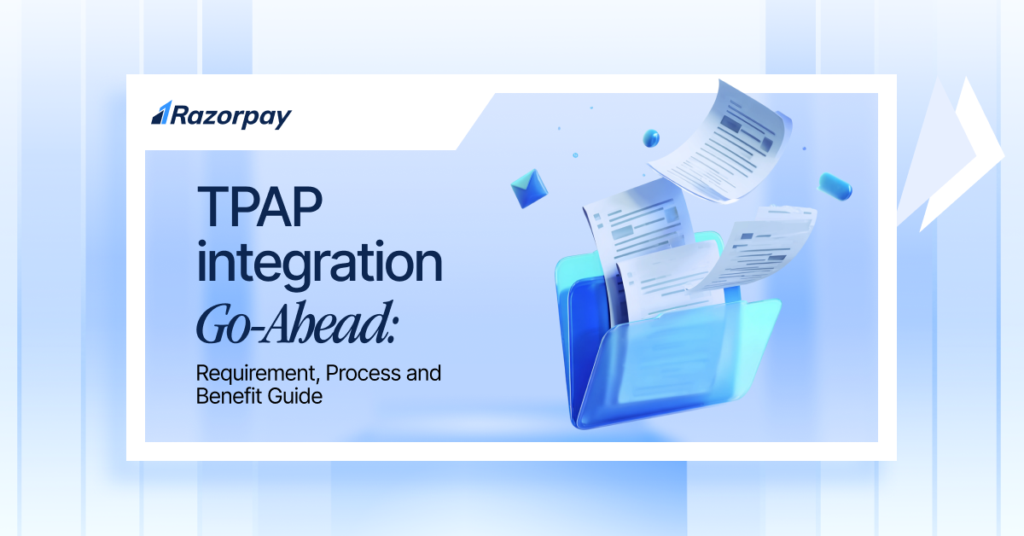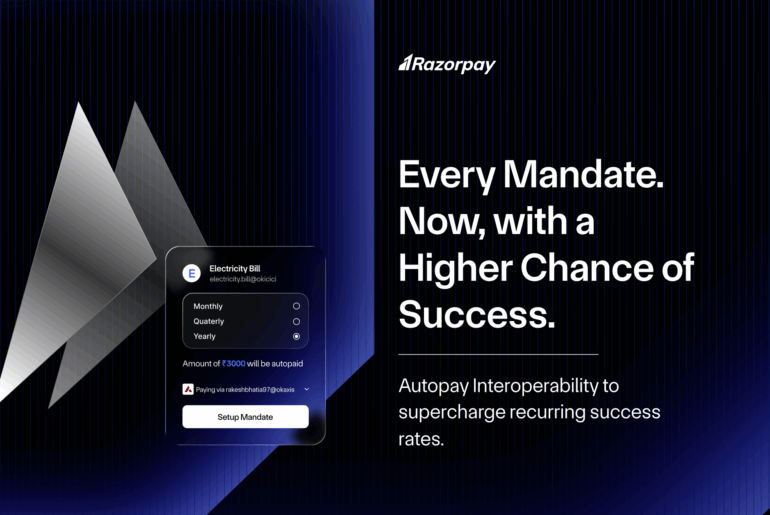As UPI increasingly becomes the default method for billions, businesses are increasingly prioritising user experience & data security on UPI. This means eliminating redirections to third-party UPI apps, and building custom in-app experiences leveraging the UPI Plugin, or choosing to become a full fledged TPAP.
Beyond the user experience, there are other strategic reasons too. For fast-growing fintechs, lending platforms, or even consumer-facing apps with large user bases, becoming a TPAP opens up better monetisation opportunities, tighter integration with the UPI infrastructure, and more flexibility to shape the payment experience end-to-end.
But in order to operate as a TPAP, you need the go-ahead from the National Payments Corporation of India (NPCI). This grants third-party apps official access to UPI infrastructure, provided they meet specific compliance, security, financial stability, and technical standards.
So how do you get one? Let’s dive into the process.

What Does the TPAP Go-Ahead Actually Allow You To Do?
At its core, a TPAP integration go-ahead gives your business the official go-ahead to offer UPI services directly to users – under your own brand and interface. Instead of relying on third-party UPI apps, you get to build your own experience, manage transactions end-to-end, and integrate tightly with the UPI infrastructure.
But itits is more than just access. It’s a signal of credibility – showing that your app meets the technical, compliance, and security standards laid out by the NPCI.
It opens the door to deeper integration with banking partners and PSPs, helps you stay compliant with regulatory frameworks, and positions your business as a serious player in the payments ecosystem.
Here’s what the TPAP go-ahead enables you to do:
- Seamlessly integrate UPI into your own app without redirecting users to external platforms
- Access the UPI infrastructure through authorized PSP banks
- Offer a custom, branded UPI payment experience that builds trust and loyalty
- Strengthen regulatory compliance and align with NPCI’s standards on security and governance
- Unlock new monetisation opportunities through deeper control over payments and data
- Go live faster on new UPI features tailored to your use case (like UPI Lite, Credit on UPI, and more)
- Build long-term credibility with users, partners, and financial institutions
Is a TPAP Go-Ahead Mandatory for UPI Apps?
If you’re building a UPI-enabled app and want to access the UPI network directly – to initiate transactions, create virtual payment addresses (VPAs), and manage user flows – then yes, you need the TPAP go-ahead from NPCI. This ensures you’re authorised to operate independently within the UPI ecosystem.
In addition, you must also partner with acquiring banks to support the acquisition leg of your transactions (P2M). To do this, businesses choose to either go through the entire certification process on their own, and partner with a bank independently, or they partner with a payments provider like Razorpay to build out their entire TPAP application.
On the other hand, if you’re not a TPAP, and choose to go the UPI Plugin route, your app must rely on a partner – such as a PSP bank or an existing TPAP – to facilitate UPI payments. This limits your ability to control the payment flow, brand experience, and technical roadmap. Learn more about the differences between becoming a TPAP and choosing to leverage a UPI Plugin here.
Now let’s look at the eligibility criteria for obtaining a TPAP go-ahead.
Who Can Apply? Eligibility Criteria for TPAP
The NPCI has set specific eligibility criteria to ensure that only qualified and capable entities operate within the sensitive UPI ecosystem.
To be eligible for a TPAP go-ahead, applicants typically must:
- Be a fintech company, payment service provider, or app developer with a functioning digital payment or UPI-enabled interface.
- Demonstrate robust technological infrastructure capable of securely managing UPI transactions, including compliance with NPCI’s security and data localization standards.
- Show financial stability and operational readiness to handle the volume and scale of UPI payments responsibly.
- Comply with all NPCI guidelines regarding technical, operational, and regulatory requirements for UPI participation.
List of Documents Needed for TPAP Application
Before you can officially apply, you’ll need to prepare a comprehensive set of documents to demonstrate your business’s technical readiness, financial stability, and regulatory compliance. Here’s what you’ll typically need to submit:
- Company KYC documents (PAN, Certificate of Incorporation, GST registration, etc.)
- Audited financial statements for the past 2–3 years
- Business plan outlining your UPI use case and expected transaction volumes
- Technical architecture document showing how your app integrates with UPI systems
- Information security policies and certifications, such as ISO 27001
- Disaster recovery and business continuity plans
- Details of partnerships with banks (if any) or PSP banks
- Board resolution authorizing the application
- Declaration of compliance with NPCI and RBI regulations
Step-by-Step TPAP Registration Process
Now let’s get into the step by step process to apply for and obtain the TPAP go-ahead –
Step 1: Confirm Eligibility
As discussed earlier, before you apply, make sure your business qualifies to become a TPAP. NPCI typically expects the applicant to meet the following conditions:
- You are a registered legal entity in India (Private Limited, LLP, etc.)
- Your company is a fintech, payment service provider, or consumer app developer
- You have a live or ready-to-launch app with a potential UPI use case
- You can demonstrate financial stability, with audited financials and investment backing (if applicable)
- You have the technical infrastructure to handle UPI transactions securely and efficiently
- You are ready to comply with NPCI’s guidelines on data storage, fraud monitoring, security audits, and customer grievance redressal
Step 2: Gather Required Documents
NPCI requires a detailed set of documents to process your application. These include:
- Company KYC documents (PAN, incorporation certificate, GST)
- A board resolution authorising UPI participation
- Recent financials or proof of funding
- A clear UPI use case and business plan
- Technical architecture and API documentation
- Information security policies and support workflows
Step 3: Submit Application on NPCI Portal
Once you’re ready, head over to the NPCI portal and follow these steps:
- Register as a New Applicant or log in if you already have credentials
- Fill out the TPAP Application Form with company details, contact info, and business overview
- Upload the necessary documents in the specified format (PDFs, size limits apply)
- Review and digitally sign the declarations
- Submit the application
You’ll receive an acknowledgement with a reference number for tracking.
Step 4: Preliminary Review by NPCI
NPCI’s UPI team will review your submission for completeness and eligibility. If any documents are missing or unclear, you’ll be asked to respond with clarifications.
At this stage, NPCI may also schedule a discussion or ask for a detailed walkthrough of your app’s UPI use case, including customer journey and data flows.
Step 5: Sandbox Testing & Technical Evaluation
If your application passes the initial checks, NPCI will invite you to the UPI sandbox environment for testing.
You’ll need to:
- Integrate with UPI APIs via a sponsor bank
- Demonstrate end-to-end transaction flows: collect, pay, refund, failover handling
- Run simulations of edge cases and exception handling
- Submit logs, reports, and audit trails from testing
NPCI and your partner bank will jointly review your test results and approve for production only if standards are met.
Step 6: Final Approval & Go-Live
Once sandbox testing is successfully completed and your app is deemed compliant:
- NPCI grants the official TPAP go-ahead
- You’ll sign agreements with NPCI and your sponsor bank
- A formal onboarding process will begin, including production key exchange, transaction monitoring setup, and daily reporting standards
Your app can now offer UPI services directly under its own brand.
Other Details: Fees & Timeline
- Application Fees: These may vary depending on the type of business and sponsor bank. NPCI itself doesn’t list a fixed fee, but banks may charge evaluation and integration fees.
- Timeline: The entire process may take anywhere from 8–12 weeks, assuming documents are in order and there are no major delays during sandbox testing.
How to Track Application Status
You can monitor your application via the NPCI portal using the reference number. Status updates are also shared via registered email. If there are long delays, you can reach out to NPCI’s UPI onboarding team directly or follow up via your sponsor bank.
Compliance Requirements After Getting the TPAP Go-Ahead
Becoming a TPAP also comes with ongoing responsibilities to ensure continued access to UPI infrastructure and alignment with NPCI’s evolving standards. Here are the key ongoing requirements:
- Periodic Audits: TPAPs must undergo regular audits – both internal and external – to assess system integrity, security protocols, and performance benchmarks.
- Data & Infrastructure Reporting: TPAPs are required to periodically share transaction data, user metrics, and operational reports with NPCI to maintain transparency and network reliability.
- System Updates: Any changes to the app’s architecture, security framework, or user interface must be reported and may require validation to ensure they remain compliant with UPI standards.
- Grievance Redressal Mechanism: A defined SOP for customer dispute handling and resolution must be maintained and updated regularly.
- Cybersecurity & Data Protection: TPAPs must continuously monitor for fraud, follow data encryption best practices, and comply with IT Act and RBI cybersecurity norms.
Failure to meet these compliance obligations can result in penalties, restrictions on UPI access, or even suspension of the integration.
Final Word
For any business looking to offer UPI payments through its own app, getting a TPAP go-ahead from NCPI is an important step. It ensures you’re operating with the required approvals, helps build user trust, and gives you direct access to the UPI network.
From offering a more controlled and branded payment experience to staying compliant with NPCI’s guidelines, it helps set up the right foundation for UPI-enabled growth.
If you’re planning to apply, making sure your documents and processes are in place will make for a smoother application journey!

Frequently Asked Questions
- What are the prerequisites for a TPAP application?
Applicants must be registered entities with a functioning UPI interface, meet NPCI’s technical and financial criteria, and submit all required documents. - Can foreign companies apply to become a TPAP in India?
Foreign companies can apply only if they have a registered Indian entity that meets NPCI’s eligibility and compliance requirements. - What happens if my TPAP application is rejected?
You will receive reasons for rejection and can address the issues before reapplying after making necessary corrections. - Do TPAPs need to follow any security guidelines?
Yes, TPAPs must comply with NPCI’s security standards, including data protection, encryption, and fraud prevention measures. - Can a TPAP go-ahead be transferred?
No, a TPAP integration go-ahead is non-transferable and tied to the original applicant entity. - How can I track the status of my TPAP application?
Applicants can track their application status through the NPCI portal or the official communication channels provided during application. - What happens if I don’t renew on time?
Failure to renew on time may lead to suspension or cancellation of the go-ahead, affecting your ability to operate on UPI.



